Introduction to Vehicle Dynamics and It’s Key Components
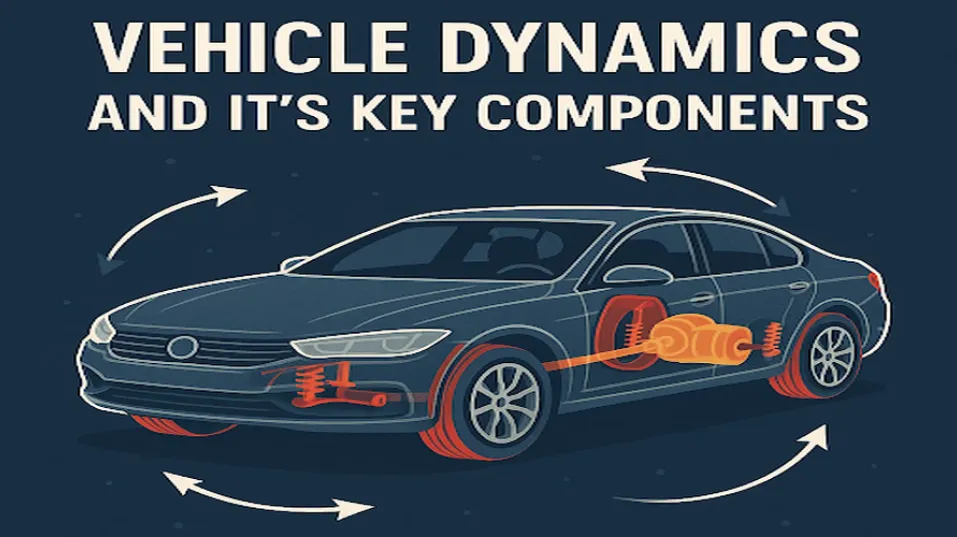
Vehicle dynamics is the study of a vehicle's behaviour in motion, encompassing aspects such as acceleration, braking, steering, & ride comfort. It applies principles of physics and engineering to analyse, model, and optimise a vehicle’s motion, ensuring stability, safety, & performance across different terrains and scenarios
How Does Vehicle Dynamics Work?
Vehicle dynamics work by analysing how various components, such as tyres, brakes, suspension, & steering systems, interact with each other and with the contact surface.
1. Driver Input: When a driver steers, accelerates, or brakes, they exert forces and moments on the vehicle.
2. Vehicle Response: These driver inputs cause the vehicle to accelerate, decelerate, change direction, or alter its roll & pitch angles.
3. Forces and Moments: The forces can act on the vehicle in three directions: longitudinal (forward and backwards), lateral (side to side), & vertical (up and down).
4. Dynamic Response: The vehicle's dynamic response is a combination of these forces & moments, as well as the vehicle's physical characteristics (weight, suspension, etc.).
5. Control Systems: The vehicle uses systems like ESC & TCS to automatically adjust braking and power for improved stability and control.
6. Predictive Control: Vehicle dynamics control systems predict instability using driver inputs & sensor data and respond by adjusting braking or engine power to maintain control.
Fundamental Principles of Vehicle Dynamics
Newton’s Laws of Motion
These basic laws help explain how forces make the vehicle move, stop, or change direction.
Friction
Friction between the tires & the road is very important. It helps the vehicle stay stable, grip the road, and brake safely.
Aerodynamics
Air pushing against the vehicle affects how it moves. Downforce helps the vehicle stick to the road & air resistance (drag) can slow it down. Both are important for stability and control, especially at higher speeds.
These principles form the foundation of vehicle motion and are essential for understanding the dynamic behaviour of automobiles. By applying these concepts, engineers can design vehicles that offer improved safety, comfort, and handling, while drivers can better understand the factors that contribute to a smooth and stable driving experience.
In automotive vehicle dynamics, these forces control how a car behaves:
- Gravity pulls the car down.
- Friction helps tires grip the road.
- Inertia keeps the car moving straight.
- Centripetal force helps the car turn safely.
Key Aspects of Vehicle Dynamic Principles
Kinematics
Kinematics refers to the study of a vehicle's motion, its position, speed, and acceleration, without initially considering the forces that cause this motion.
This approach, often referred to as kinematics, focuses on describing how a vehicle moves, laying the groundwork for more advanced analysis involving the underlying forces and dynamics.
Key Points About Kinematics:
- Describes how a vehicle moves along the road surface.
- Analyses the vehicle’s position, velocity, and acceleration over time.
- Does not account for external forces such as gravity, friction, or aerodynamic drag.
- Focuses solely on the motion and trajectory of the vehicle, independent of the forces causing it.
Kinetics
Kinetics is the study of the forces & moments that cause and influence a vehicle’s motion.
It explains how various forces, such as traction, braking, and lateral forces, affect the vehicle during acceleration, deceleration, and cornering. Understanding these dynamics is essential for designing vehicles that are stable, responsive, and safe under real-world driving conditions.
Key Points About Kinetics:
- Explains why a vehicle moves the way it does under various driving conditions.
- Analyzes the forces and moments acting on the vehicle during motion.
- Describes how these forces influence acceleration, braking, and cornering performance.
- Focuses on the impact of factors such as gravity, friction, tyre forces, and engine power on vehicle behaviour.

Forces in Vehicle Dynamics
Forces are the different pushes & pulls that act on a car while it is moving. These forces help control how the car speeds up, slows down, turns, & handles bumps on the road.
Types of Forces:-
- Longitudinal dynamics – Forward and backwards (braking and accelerating)
- Lateral dynamics – Side to side (steering and swerving)
- Vertical Forces: These forces come from the suspension system. It helps the vehicle handle bumps & stay stable.
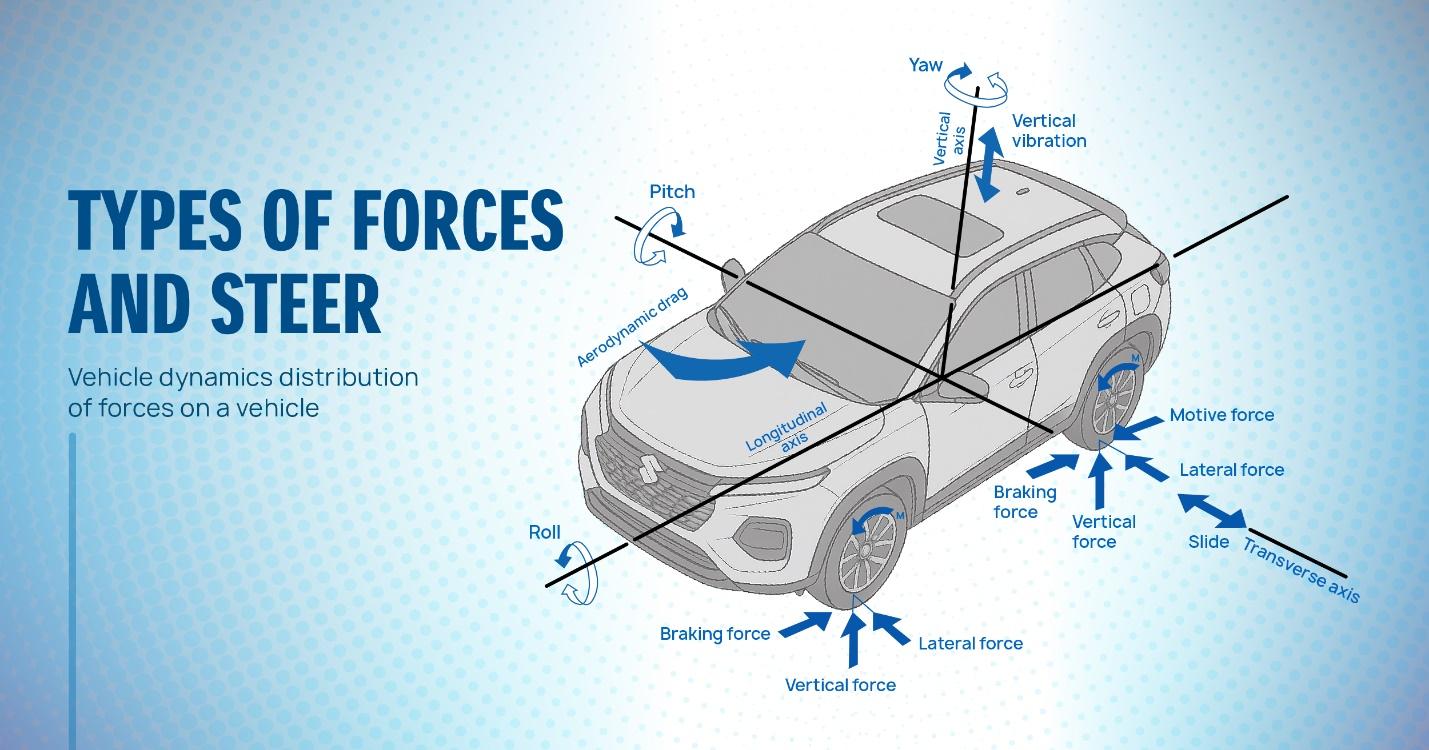
Moments in Vehicle Dynamics
Moments are about how the car rotates or tilts in different directions while driving. Moments help explain how the car changes its direction or balances during a turn, brake, or quick movement.
Types of Moments:-
- Yaw Moment: The car rotates left or right around its centre, like turning in a circle.
- Roll Moment: The car tilts side to side when turning, like leaning during sharp corners.
- Pitch Moment: The car tilts forward or backward, like when braking or speeding up.
Key Components of Vehicle Dynamic Principles
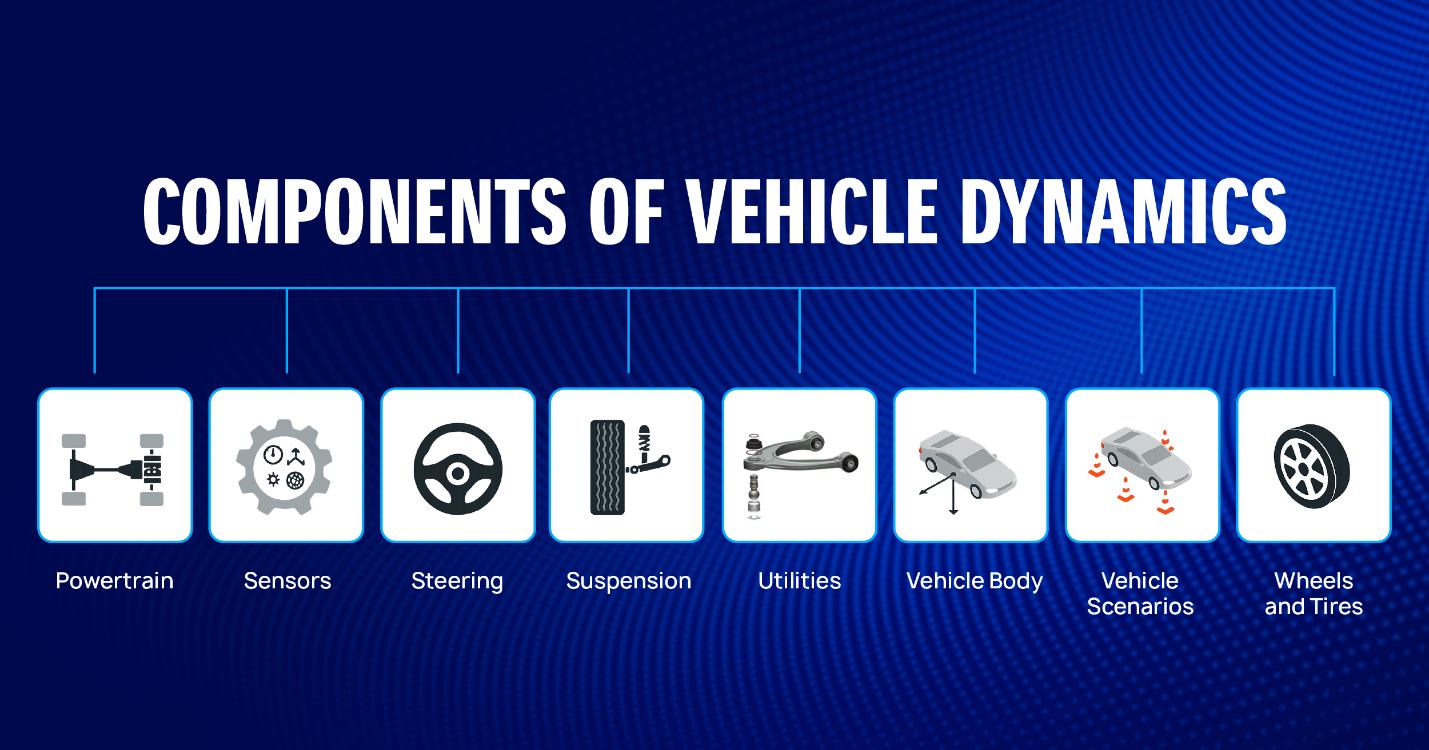
The Role of Tires in Vehicle Dynamics
Tires play a crucial role in automotive vehicle dynamics and overall driving performance.
Tires in good condition provide better traction, handling, & stability. Here are key factors to consider:
- Tire pressure affects comfort and grip.
- Tread pattern helps in the rain.
- Tire material affects grip and wear.
Suspension System and Ride Comfort
The suspension system plays a crucial role in vehicle dynamics. It ensures the car remains stable and keeps the tires in constant contact with the road for better control and safety.
Parts of suspension:-
- Springs to absorb bumps
- Shock absorbers to control movement
- Anti-roll bars to reduce side tilting
A well-designed suspension system ensures a smoother ride & enhances the vehicle's overall performance by improving comfort, stability, and control.
Steering and Handling
Smooth steering gives you better handling, making driving smoother, safer, and more enjoyable. Several factors influence how well a vehicle responds when turning or changing direction:-
- Steering type (hydraulic or electric)
- Wheel alignment (toe, camber, caster)
- Steering ratio (how much you turn the wheel)
- Weight distribution (balanced weight helps turn better)
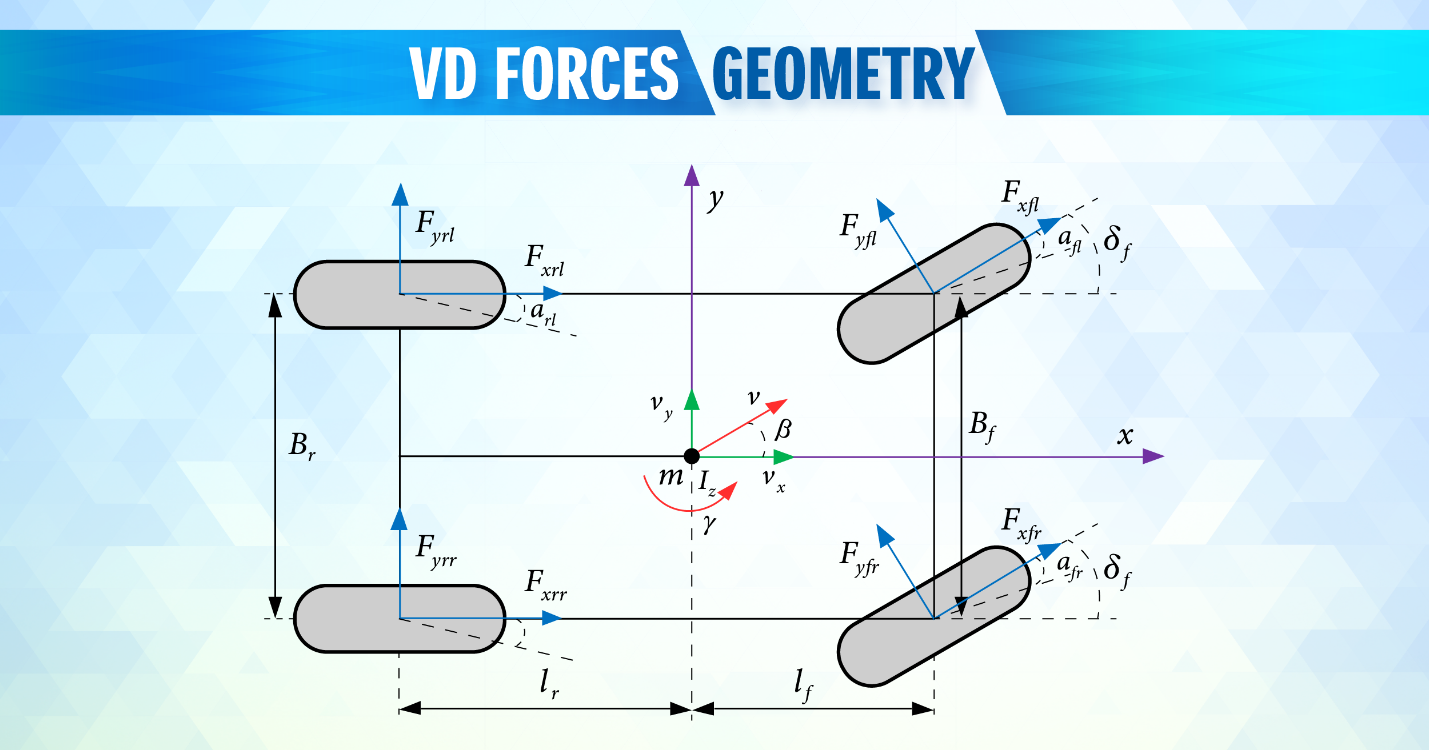
Weight Distribution
Weight distribution means how the weight of the vehicle is spread from front to back & side to side. It affects how the car behaves when turning, braking, or accelerating.
- Good weight distribution keeps the car stable & balanced.
- Affects how easily the car can turn, speed up, & stop.
- Helps improve handling & safety on the road.
Aerodynamics
A better aerodynamic design of the vehicle reduces air resistance (drag), boosting fuel efficiency and enhancing stability at higher speeds.
- Downforce helps push the car down on the road for better grip.
- Drag is the air resistance that slows the vehicle down.
- Good aerodynamics improve stability, fuel efficiency, & performance.
Modes of Motion in Vehicle Dynamics
Longitudinal Dynamics
- The vehicle moves forward or backwards
- Includes acceleration (speeding up) & braking (slowing down)
Lateral Dynamics
- The vehicle moves side to side
- Includes steering and turning
Vertical Dynamics
- The vehicle moves up & down
- Affects how the vehicle handles bumps & uneven roads
- Helps to keep the ride comfortable & stable
Vehicle Dynamics in Conventional, Electric, and Autonomous Vehicles
Benefits of Vehicle Dynamics
- Better handling and control
- Improved safety
- More comfort for passengers
- Smoother & more fun driving experience
Understanding the Role of a Vehicle Dynamics Engineer
A vehicle dynamics engineer ensures the car feels good to drive. They work on vehicle system dynamics to improve safety, comfort, & performance and are proficient in handling everything from testing cars to using vehicle dynamics modelling. Proficient in special computer tools, math, & real driving tests to evaluate performance and identify areas for improvement.
Skills Needed for Vehicle Dynamics Engineers
A good vehicle dynamics engineer needs:
- Knowledge of automotive vehicle dynamics
- Software skills (MATLAB, CarSim, Simulink)
- Good math & physics knowledge
- Testing & analysing cars
- Teamwork for design
These skills help in creating cars with better automotive dynamic performance.
Simulation and Testing Tools Used for Vehicle Dynamics Testing
Engineers use tools for vehicle dynamics modelling:
- MATLAB/Simulink for calculations
- CarSim, IPG CarMaker for simulations
- Real-world tests on tracks
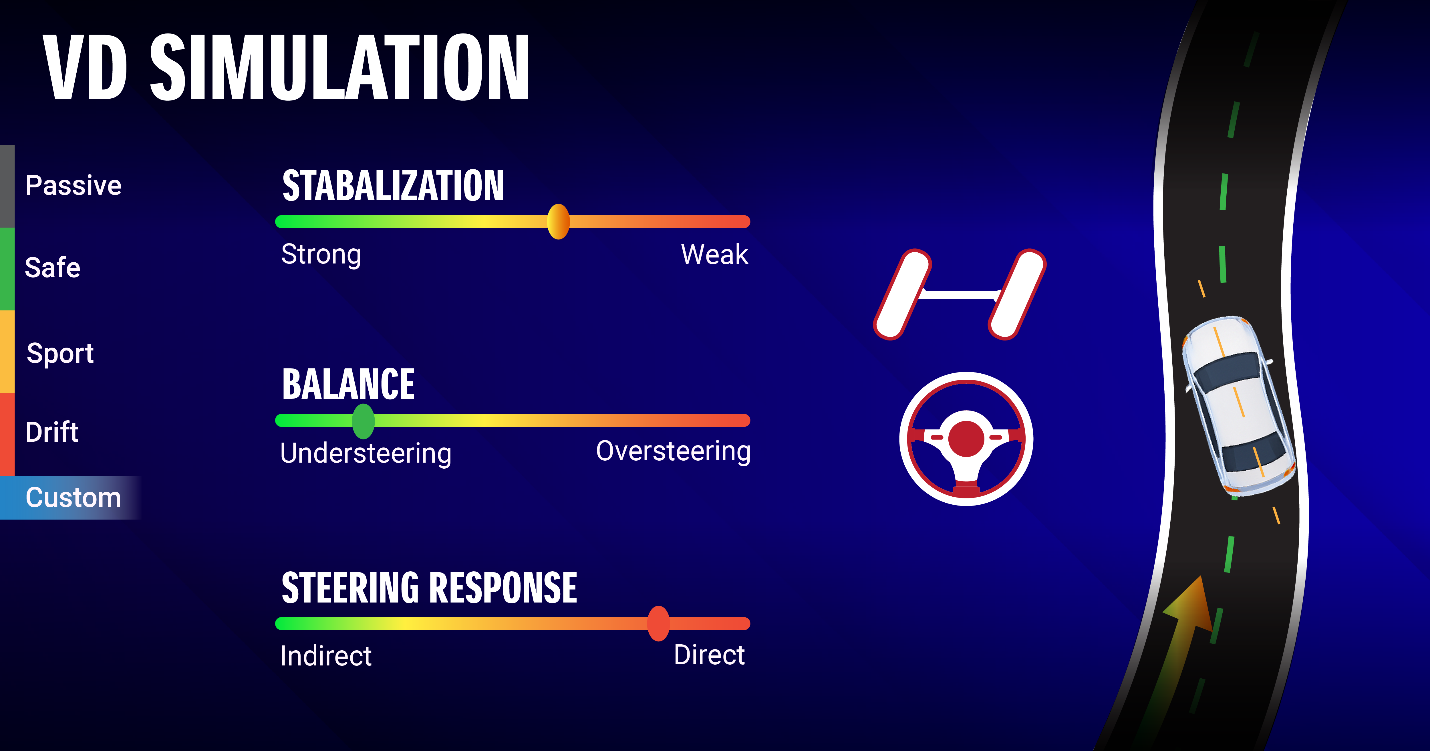
AI-powered tools are further enhancing these simulations. Increasingly, AI is being used to enhance these simulations, helping identify issues faster and make smarter design decisions.
Explore how AI is driving advancements in the automotive industry.
Some Important Terms in Vehicle Dynamic Systems
- Understeer: Front tires lose grip, and the car doesn’t turn enough.
- Oversteer: Back tires lose grip, car turns too much.
- Yaw: The vehicle turns left or right around its middle.
- Pitch: Vehicle tilts forward or backward.
- Roll: The vehicle tilts side to side during turns.
These terms are necessary to understand how a car moves, turns, & stays balanced so engineers/drivers can make it safer and more comfortable to drive.
Suzuki R&D: Enabling Smart & Sustainable Four-Wheelers
SRDI drives innovation in automotive research, IT, and product development, helping Suzuki build advanced four-wheelers that are safe, efficient, and future-ready.
Using tools like CAE and a strong focus on vehicle dynamics, we ensure Suzuki vehicles offer smooth, stable, and comfortable performance on Indian roads.
Our commitment to continuous R&D supports Suzuki in delivering four-wheelers that not only enhance driving comfort but also contribute to sustainable mobility solutions.
